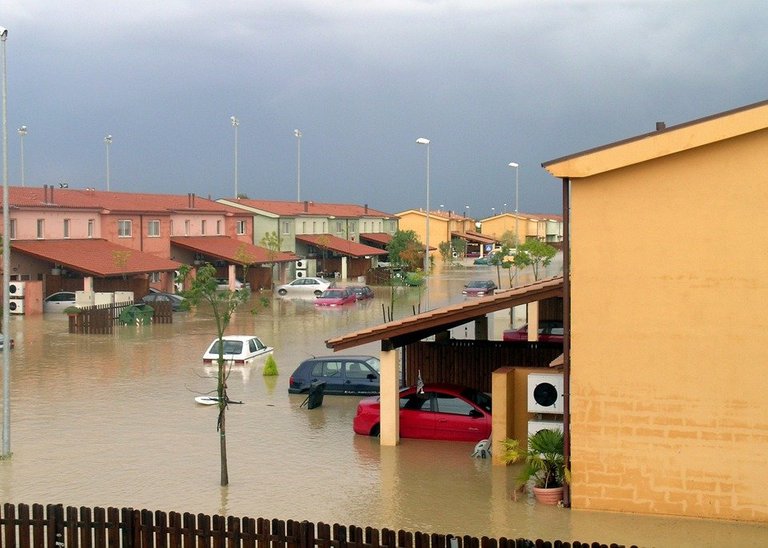A new urban focus. Find out which one// Un nuevo enfoque urbano. Descubre cuál es
Greetings to my dear hivers and the Architecture+Design community
Perhaps you have heard that more and more glaciers are melting, causing the sea level to rise and generating floods, which cause unfortunate human and material losses.

Why is this happening? The answer is due to climate change. This is a phenomenon that modifies the climate due to global warming, all this caused by bad human practices that alter the environment.
But why do engineers and architects need to know about climate change? The answer is because they need to change the traditional paradigm of city design and development. They need to contribute ideas and actions to achieve goods, services and infrastructures that are in harmony with the environment.
One of the new challenges of urban design is to achieve more efficient, resilient and sustainable infrastructure. Is this possible? The answer is yes, but it is a path to follow; it is difficult to achieve it from one day to the next; however, it is necessary to start.
Resilient means adapting to adversity and in this case, the purpose is to achieve an infrastructure that adapts more easily to the conditions imposed by climate change.

Today I bring to the table the case of urban roads, specifically "pavement structures". It is common to see the streets and avenues of our cities built with asphalt and concrete, these wonderful materials that give us resistance and durability, but why is that? and the answer is that apart from the composition of the material, its impermeability has a great influence.
When I studied civil engineering, my professors emphasized the importance of building impermeable pavements, since water was the enemy of construction. By following these practices, the most optimal design mixes were achieved to achieve this "waterproofing" purpose, which would guarantee a longer useful life for the structures or elements built. It meant a whole engineering solution.
However, change is the only constant, and nowadays it is necessary to study the needs with an integrated approach; it is not enough to solve a problem, but to solve it properly thinking about sustainability and resilience. Two concepts that should be the basis for all urban design.

But what problem have we observed in impervious pavements? It has been observed in recent years that due to the climate effect, torrential rains and floods have increased. This has led to an increase in the amount of water runoff on streets and avenues. Often the rainwater collectors do not have sufficient capacity to withstand these high water loads.
On the other hand, replacing the pipe networks with a larger diameter represents a solution with a very high investment cost that the State will not always be willing to accept, in addition to the fact that there is greater uncertainty in the prediction models of the project, in terms of short, medium or long term, depending on the ravages caused by the climatic effect.

In this sense, the idea arises of evolving in the area of road pavements and moving from impermeable structures to others that allow water to percolate, and thus reduce surface runoff in urban roads, drain the public network of rainwater, with the consequent benefit of accelerating the water cycle, by reducing the time in the incorporation of this water to the water table and tributaries.

There are other advantages in the use of permeable pavements, such as reducing the amount of contaminated water to be introduced into treatment plants, reducing the heat of the city, since it reduces the evaporation effect of runoff water, minimizing irrigation activities in green areas and generally reducing maintenance costs.
The permeable pavements par excellence are those built with "cobblestones", which have a variety of designs, which can be very decorative, both for road and pedestrian circulation areas and green areas; however, they can also be built with asphalt and porous concrete to comply with the condition of allowing water to pass from the top to the bottom.

I hope you liked the information, as you can see, permeable pavements are the pavements of the future and research lines are handled to achieve greater strength and durability.
Written by Alexandra Torres . On Hive.Blog @xandra79
References .
EcoHabitat website (S/f). [Online article]. Stormwater: permeable paving and water harvesting in cities. Retrieved from. Accessed March, 2021.
El Pais website (2019). [Online article]. why it is urgent to remove asphalt from cities (and Barcelona has already started). Retrieved from. Accessed March, 2021.
Free images from Pixabay 1 2 3 4 5 6
The heart separator was made by me.

About me
My name is Alexandra, I am a Civil Engineer, graduated from Universidad Centroccidental Lisandro Alvarado (UCLA), a prestigious university in Barquisimeto, Lara State, Venezuela.
I have 17 years of experience in the construction sector in the areas of consulting, projects, execution of works, control, monitoring and audits.
I love Sustainable Development and focus on Civil Engineering and Urban Design. In opportunities I write about this subject, I think it is my way to contribute a grain of sand for humanity and for this beautiful planet called "Earth".
Translated with www.DeepL.com/Translator (free version)

Saludos a mis queridos hivers y a la comunidad Architecture+Design
Quizás han escuchado que cada vez más se descongelan los glaciares, ocasionando que el nivel del mar aumente y se generen inundaciones, que ocasionan lamentables pérdidas humanas y materiales.

¿Por qué sucede esto? La respuesta es debido al cambio climático. Este es un fenómeno que modifica el clima a causa del calentamiento global, todo esto provocado por las malas prácticas humanas que alteran el ambiente.
¿Pero por qué los ingenieros y arquitectos necesitan saber del cambio climático? La respuesta es porque necesitan cambiar el paradigma tradicional de diseño y desarrollo de las ciudades. Aportar ideas y accionar para lograr bienes, servicios e infraestructuras cónsonas con el ambiente.
Uno de los nuevos retos del diseño urbano es lograr una infraestructura más eficiente, resiliente y sostenible. ¿Es esto posible?. La respuesta es si, pero es un camino a seguir; es difícil lograrlo de un día para otro; sin embargo es necesario comenzar.
Resiliente significa adaptarse a las adversidades y en este caso, el propósito es lograr una infraestructura que se adapte con mayor facilidad a las condiciones que impone el cambio climático.

Hoy traigo a la mesa el caso de la vialidad urbana, específicamente "las estructuras de los pavimentos". Lo común es ver las calles y avenidas de nuestras ciudades construídas con asfalto y concreto, estos materiales maravillosos que nos regalan resistencia y durabilidad, pero ¿por qué será? y la respuesta es que aparte de deberse a la composición del material, influye en gran medida su impermeabilidad.
Cuando estudié ingeniería civil, mis profesores resaltaban la importancia de construir pavimentos impermeables, ya que el agua era el enemigo de la construcción. Haciendo caso a estas prácticas se lograban las mezclas de diseño más óptimas para lograr este propósito "impermeabilidad", esto nos garantizaría mayor vida útil en las estructuras ó elementos construídos. Significaba toda una solución en ingeniería.

No obstante, el cambio es lo único constante, y en la actualidad es necesario estudiar las necesidades con un enfoque integrador; no basta resolver un problema, sino resolverlo adecuadamente pensando en sostenibilidad y resiliencia. Dos conceptos que deben ser la base para todo diseño urbano.
¿Pero qué problema hemos observado en los pavimentos impermeables?. Se ha observado en los últimos años que por el efecto climático, aumentan las lluvias torrenciales y las inundaciones. Esto ha conllevado a aumentar la cantidad de agua por escorrentía en las calles y avenidas. Muchas veces los colectores de aguas de lluvia no cuentan con la capacidad suficiente para soportar estas altas cargas de agua.
Por oro lado, sustituir las redes de tuberías por un mayor diámetro, representa una solución con un costo de inversión muy alto que el Estado no siempre estará dispuesto a aceptar, aunado también a que existe mayor incertidumbre en los modelos de predicción del proyecto, en términos de corto, mediano o largo plazo, dependiendo de los estragos que causa el efecto climático.

En este sentido, surge la idea de evolucionar en el área de los pavimentos viales y pasar de estructuras impermeables a otras que dejen percolar el agua, y de esta manera disminuir la escorrentía superficial en la vialidad urbana, desagohar la red pública de aguas de lluvia, con el consecuente beneficio de acelerar el ciclo del agua, al aminorarse el tiempo en la incorporación de esta agua al nivel freático y afluentes.

Existen otras ventajas en el uso de pavimentos permeables, como lo es disminuir la cantidad de aguas contaminadas a introducir en las plantas de tratamiento, disminuir el calor de la ciudad, ya que merma el efecto de evaporación de las aguas de escorrentía; minimizar las actividades de riego de áreas verdes y en general disminuir los costos de mantenimiento.
Los pavimentos permeables por excelencia son los construidos con “adoquines”, los cuales poseen variedad de diseños, que pueden resultar muy decorativos, tanto para áreas de circulación vial como peatonal y áreas verdes; sin embargo también pueden construirse con asfalto y concreto poroso para que cumpla con la condición de dejar pasar el agua de arriba hacia abajo.

Espero que les haya gustado la información, como podrán observar los pavimentos permeables son los pavimentos del futuro y se manejan líneas de investigación para lograr mayor resistencia y durabilidad.
Escribió para ustedes Alexandra Torres. En Hive.Blog @xandra79

Referencias
Sitio web EcoHabitar (S/f). [Artículo online]. Aguas pluviales: Pavimentación permeable y recolección de agua en las ciudades. Recuperado de. Consulta: Marzo, 2021.
Sitio web El País (2019). [Artículo online]. ¿Por qué es urgente eliminar el asfalto de las ciudades (y Barcelona ya ha empezado)?. Recuperado de. Consulta: Marzo, 2021.
Imágenes libres de pixabay 1 2 3 4 5 6
El separador de corazones fue realizado por mí.

Sobre mí
Mi nombre es Alexandra, soy Ingeniero Civil, egresada de la Universidad Centroccidental Lisandro Alvarado (UCLA), una prestigiosa universidad de Barquisimeto, Estado Lara, Venezuela.
17 años de experiencia en el sector construcción en las áreas de asesoría, proyectos, ejecución de obras, control, seguimiento y auditorías.
Me encanta el Desarrollo Sostenible y enfocarlo a la Ingeniería Civil y Diseño Urbano. En oportunidades escribo sobre esta temática, pienso que es mi manera de aportar un grano de arena por la humanidad y por este hermoso planeta llamado “Tierra”.

Excelente contenido, muy didáctico y con una visión integral de la ingeniería, saludos!
Posted using Dapplr
Muchas gracias @chaodietas por tu comentario y por darte un tiempo para leer mi publicación.
They look very beautiful also, I wonder what the expense is. I think I've read somewhere in Australia we have started using solar panel roads also. That's pretty cool.
Hello @melbourneswest. Good thing Austrialia is putting up solar panels. We should not be passive in the problem of the climate effect because it affects all of us. To answer your question, I can tell you that the permeable pavements are more economical than traditional pavements, so the cost-benefit ratio is higher. It is the resistance factor that prevents it from being the first option for roads with higher vehicular traffic; however, research in the area is looking for a solution.
Yes definitely agree, we need alot more things that mitigate global warming. Unfortunately we're not fish and can't live under water
Hola, veo que eres muy consciente del problema que enfrente nuestra generación (tengo 26) , me alegra que lo transmitas en este grupo , es un gran aporte. Y no está de más como paisano notarlo que felicidades por tan buenas recompensa jaja
Hola @feiderman. Gracias si, es que el ambiente lo llevo en el alma y hay que pensar en las generaciones futuras, no podemos ser tan egoístas. Muchas gracias paisano, te deseo muchos éxitos y bendiciones!!!
Hi @xandra79! Excellent engineering insight about pavement construction! With the core purpose of protecting our planet from the harsh effects of global warming, these structures definitely contribute to better sustainability and minimize climate change.
What about countries where there's minimal rainfall like those nations where deserts abound such as the Middle East? Will they also benefit from permeable pavements?
Hi @storiesoferne. Very pleased with your feedback. My Answer: No corner of the planet escapes the effects of climate change; in fact the Middle East experienced impressive flooding in its deserts in 2018. You can see it here and in the videos below. Likewise, in December of last year there were torrential rains and floods in Israel and in February 2021 there was a snowfall and hurricane force winds that affected several countries in the Middle East.
We are seeing unusual things and when it comes to climate change in the same place it can be subject to extreme drought and then extreme floods. I present other cases: In Madrid it snowed at the beginning of the year, in my country Venezuela last year the Limón River overflowed, this year an iceberg the size of London was detached in Antarctica, in short, it will be increasingly difficult to predict weather patterns; Therefore, my recommendation is that countries prepare for floods and gradually incorporate permeable pavements in cities, which has the additional advantage that it alleviates the collection of water in the city's sewer system, which after the passing of the years it presents less capacity in the face of greater demand; In addition, the heat of the city is reduced, since the amount of surface water that is subjected to the evaporation process is less. Thanks for your comment and question. This allowed me to think about these countries.
Precisely @xandra79! Regardless of where we are in the world, permeable pavements are valuable features in the built environment for our readiness against climate change. As they say, the weather is always unpredictable. Thank you for the informative update and the eye-opening videos!
Exactly, very well said. Thanks to you for encouraging such productive discussions for the community.
This was very informative, introduction of imperviable pavements can help a lot against climate change. Cobblestone mentioned by you must solve the problem easily.
great post, keep flourishing!:)
Thank you for that motivating comment. Thanks a lot. I wish you many successes and blessings!
Wonderful post, Inculcating such factors like permeable pavements in design will help in several ways, it's high time we take climate change seriously.
I love your opinion, we need to start introducing these new ideas and make change happen. Thank you very much for your feedback.
Indeed, Have a happy weekend:)
Posh https://twitter.com/aletorres1112/status/1373673316574244871
But did you know, that no matter how architects arrange the right waterway when there is a storm or flood it does not affect? It can reduce the adverse effects of flooding, but it will not stop the flow.
An example of this is the incident in QATAR. QATAR Engineer and Architect excels in water irrigation production, a mixture of Engr and Archi of UK, Asians, and Arab. But they did not expect a catastrophe to happen!
Greetings @kennyroy. I don't know the specific case of Qatar, I know that last year it suffered floods, this year I don't know. In any case, I take this opportunity to emphasize that these permeable pavements are measures to mitigate climate change, not to avoid it. In the case of low or moderate rainfall they will work effectively, but if the flow is very high, obviously flooding will occur but less than what would have occurred doing nothing. And the problem is not being corrected from the cause, this would really be solved by changing many human practices in favor of reducing the production of CO2 in the environment, so if the real cause would be attacked, but meanwhile mitigation measures are important to avoid as far as possible human and material losses ... thanks for sharing your comment.
Perfect explanation! Good answer... (^_^)
Congratulations @xandra79! You received a personal badge!
You can view your badges on your board and compare yourself to others in the Ranking
Check out the last post from @hivebuzz:
Hola Alexandra! Me gustó mucho tu publicación y el planteamiento que hsces es de gran valor sobretodo en los últimos días con los eventos climáticos que están sucediendo.
Soy partidario de la sostenibilidad y del equilibrio que aportan esas acciones.
Hooola @carlosp18. Que gusto saludarte y conocerte a través de este comentario. Yo estuve inactiva unos cuantos meses en Hive.Blog y no te había visto. Al leer tu comentario lo primero que me pregunté es cómo conectó con mi post que ya tiene bastante tiempo publicado y revisé tu perfil y vi que has publicado en la comunidad Architecture+Design, así que deduzco que a través de ella es que hoy podemos conocernos.
Me encanta el hecho de interactuar con otros profesionales, vi que eres ingeniero civil y en tu comentario compartes que eres partidario de la sostenibilidad, así que me alegra conocerte y para mi es de gran satisfacción que te haya gustado mi publicación y que compartas la importancia que tiene este tipo de contenido y que es necesario difundir... Espero leerte pronto y que sigamos interactuando. Gracias por tu feedback y te deseo un feliz inicio de semana desde mi ciudad Barquisimeto, la ciudad crepuscular de Venezuela.
Saludos Alexandra, el tema climático últimamente ha dado mucho de que hablar, me gustaría saber tu punto de vista sobre las ciudades que tienen muchos años (mas de 300 años por decir un numero) donde han venido creciendo sin planificación alguna y ahora vemos que las amenazas climáticas se dan y los daños atentan contra la vida de los ciudadanos ¿es posible repensar la ciudad y adecuarla a nuevos tiempos? o ¿es mejor crear nuevos asentamientos?